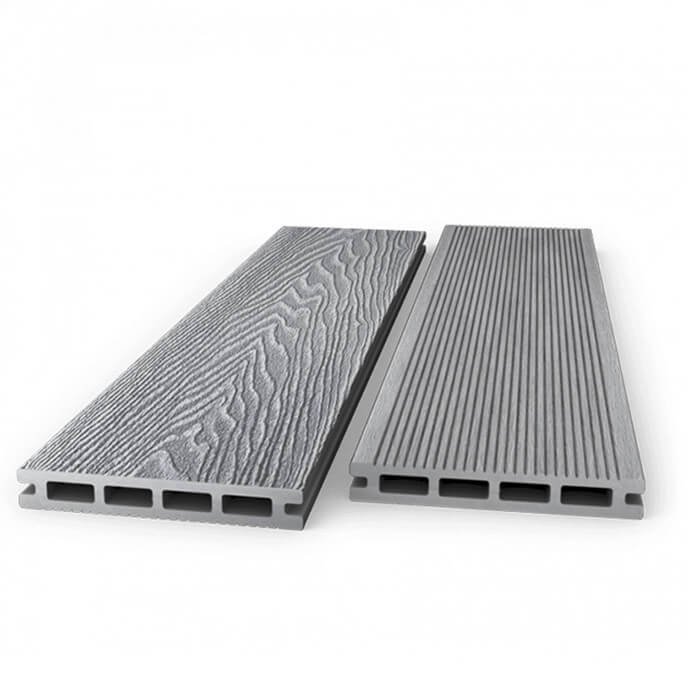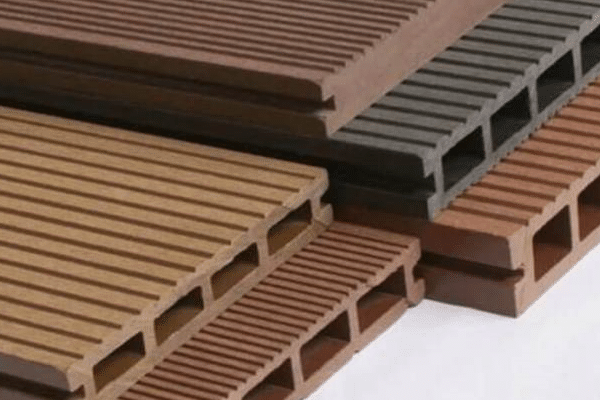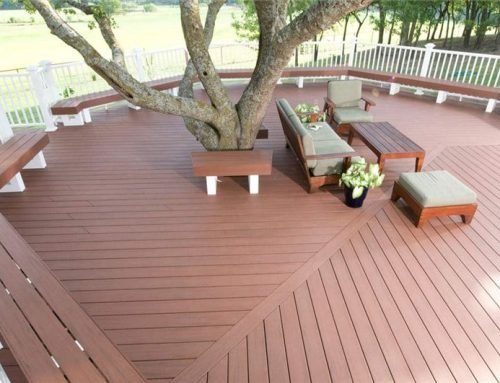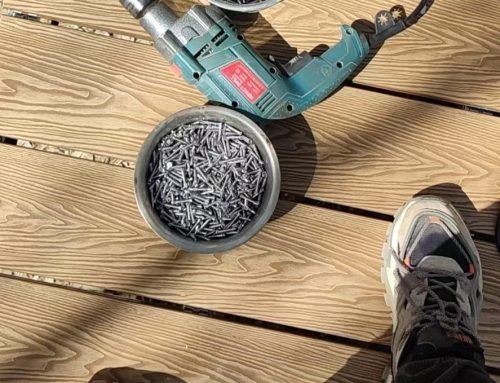What’s composite decking?
Composite decking (wood plastic composite) is a type of decking made of various artificial deck boards.
The materials used are wood peel, wood fiber, wood lust, and plastics (shredded plastic). Its formation process entails mixing two materials under high temperatures.
During the process, a substance gets included to bind them together. Once the end product cools, the composite decking boards get cut into various sizes. You’ll get an eco-friendly composite decking of wood and plastic combination.
Types of composite decking
There are various types of composite decking made by composite decking manufacturers
-
Grooved and Ungrooved
-
Capped and Uncapped
-
Solid composite decking
1. Grooved and Ungrooved

Grooved composite decking is a type of WPC deck with hollows or trenches. This means its sides aren’t smooth. The center of the sides is somehow pushed inward. This’s to create a trench running down the deck’s length.
People find grooved composite useful. It’s because it’s easy to use hidden fasteners during installation. Besides, in today’s society, many homeowners find using concealed fasteners today. Also, its finish isn’t distorted by nails or screw heads.
Ungrooved composite decking is the absolute opposite of grooved WPC deck. This decking doesn’t have trenches on its side, leaving the sides smooth.
Ungrooved composite decking gets installed by the surface installation method. The composite decking boards get fixed using nails or screws. The downside of Ungrooved composite decking is the screw head will appear on its surface. Meaning it will affect the finish and appearance of the decking.
2. Capped and Uncapped Composite Decking

Capped composite decking is wood fiber decking. Its outer surface gets coated with plastics. This type of decking is more durable as the plastics used on the outer layer don’t absorb moisture.
Uncapped Composite decking is not capped. This composite’s outer layer isn’t covered with plastic. Generally, this is also known as first-generation composite decking. It was the first composite decking ever made.
To buy composite decking in this category, you must understand its difference. You can differentiate Capped and Uncapped decking from its uses.
If you want to install your composite decking boards in an area exposed to water, then capped composite decking will be best. It’s also perfect for outdoor installation in areas such as the swimming pool.
Uncapped Composite decks are a good match for covered places like under the shade. It should not get exposed to water.
3. Hollow Composite Decking

Hollow composite decking boards, also known as black composite boards, have holes. This type of decking board is made of lightweight decking materials. The material is less resistant to impacts.
They are suitable for cladding, cable installation, siding, and more. But they do need fascia boards or caps on their edges.
The holes in the hollow composite decks are why it’s lightweight. Also, it makes expansion and contraction easy. Regarding cost, hollow is a cheap composite decking board compared to a solid composite deck.
4. Solid composite decking
As its name suggests, solid composite decking boards are heavy. These boards are for making permanent floors for hotels, houses, and offices. They also work for pathways of houses, swimming pool decks, and more.
But, solid composite decking has its downside. Solider composite boards undergo warping during extreme weather conditions. Besides, its installation needs professionalism and help because of its weight.
At KR Wood Composite, we are China’s leading WPC decking manufacturer. We provide solid, hollow, and capped composite decking. Our boards are of high quality and suitable for commercial and residential applications. We can also offer factory direct prices for the boards ordered.
Benefits of composite decking compared with wood floor
When choosing what decking to use, understand the difference between the decking options. There are two most common decking options;
-
Wood decking
-
Composite decking
Each of these options has its benefits and downside. Here is a detailed comparison to help you choose the right decking material.
First, let’s look at each of them:
1. Wood Decking
Many wood species work for decking and railing. There are various wood species for wood decking options. That includes redwood, cedar, tropical hardwood like mahogany, and exotic wood species.
2. Composite Wood Decking
Wood plastic decking, or composite wood decking, came about in the late 1980s. This decking comes in different types and is available at KR Wood Composite. Many homeowners and constructors are turning to high-performing composite decking. It’s because its benefits outweigh that of wood decking.
Why choose a wooden composite floor?
Many homeowners choose composite from decking wood suppliers. That’s because it’s easily available and affordable. Wood Decking has many problems like rot, high maintenance, and splinters.
Though composite wood decking is easy to maintain, many people feel it won’t look nice as wood decking. But, composite decking manufacturers have advanced their technology. They now produce composite decking that emulates wood’s natural looks.
Benefits of Composite Decking
1. Maintenance
Wood decking needs regular painting and sealing to prevent the effects of pests, temperature, and moisture. You will have to maintain your wooden decks annually. This means you have to include its maintenance in your budget.
Composite decking only needs washing and sweeping. This is to keep the boards neat and increase their longevity. Composite decking boards do not need sealing, staining, or painting. So, it has low maintenance.
2. Durability
Wood decking is susceptible to warping, splintering, rot, and termite damage. This downside limits its durability to a span of 10-15 years.
Conversely, composite decking is the complete opposite of wood decking. It resists warping, splintering, rots, and termite damage. This quality features increases its durability.
That explains why suppliers of composite decking boards guarantee a 25-year warranty.
Generally, the durability of WPC decking boards depends on the type of wood used. Also, the composite manufacturer plays a major role.
3. Installation
Each of these deckings has a simple and easy installation, but it somehow differs. Both get cut through and fastened with appropriate tools.
For wood decking, it can get routed, ripped, and very difficult to bend. Composite decking can also get routed, ripped, and bend with easy-to-fit any space. Also, form curved deck sections.
4. Colors
What makes composite outstanding is that it comes in various colors. You get to select from its various shades, hues, and grains, which opens you up to more decking ideas.
Popular decking brands like KR WPC decks are moisture-resistant. This allows its installation to high moisture conditions without painting and staining.
For wood decking, you don’t have lots of options to choose from. But you can paint and stain it per your preference. Painting and sealing are a must for wood decking. It’s to avoid warping, rotting, and splintering of the boards.
5. Sustainability
Sustainability is the core of everything. Unlike wood decking, composite decking is eco-friendly. Wood decking has deforestation impacts and needs decent lumber. But, with composite, no trees get destroyed.
90% of recycled materials get used to creating KR’s eco-friendly composite decking. This has helped and made it easy for plastics to go green. The FSC-certified wood and shredded plastics make composite the most sustainable deck boards.
6. Overall Investment
When comparing investments, composite decking is a long-term investment that you can make. It’s due to its low maintenance cost, increased durability, aesthetics, and environmental impact. Also, the strong warranties from the composite company make it suitable.
KR offers a 25-year warranty on all its composite decks. This is a good investment, especially for homeowners because of its quality.
Wood decking is a short-term investment as you’ll have to spend more on its maintenance to boost its durability.
The Bottom Line
Composite decking manufacturers use almost the same raw materials composition to make composite decks. What makes KR new materials unique? It is the technical team has hand on experience of over 15 years. The team allocates raw materials depending on customer requirements. This has assisted in building a reputation with customers. To learn more about composite decking and availability, please contact KR at any time.




